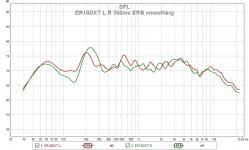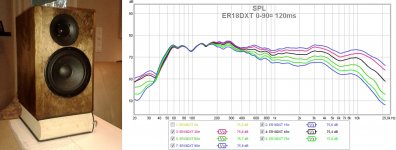Can anyone tell me why i'm hearing the tweeters?
I have build the ER18DXT which use a 2nd order slope at 1,8kHz. I believe i hear more upper mid and treble than the music itself. The ER18RNX are fine.
I have build the ER18DXT which use a 2nd order slope at 1,8kHz. I believe i hear more upper mid and treble than the music itself. The ER18RNX are fine.
With a shallow 2nd order acoustic slope the drivers should blend better and as a result it should be harder to hear the individual drivers, but a tweeter is more likely to distort with a shallow slope.
I had these years ago and felt the same. Its the dxt waveguide and the directivity. They benefit from a falling response of about 5-10db depending on your room and placement. I had better results ditching the passive crossover and using a minidsp to fine tune. But in the end I felt that the dxt tweeter was just not sounding very natural and from the limited number of people using it I gather that im not alone.
I had these years ago and felt the same. Its the dxt waveguide and the directivity. They benefit from a falling response of about 5-10db depending on your room and placement. I had better results ditching the passive crossover and using a minidsp to fine tune. But in the end I felt that the dxt tweeter was just not sounding very natural and from the limited number of people using it I gather that im not alone.
This absolutely does not mirror my experience with the DXT. In fact I find it rather polite sounding.
Agree they are.polite in the top end but a little clinical for want of a better word. Something is a bit "off" on some recordings.
I prefer scanspeak tweeters and even the RS28f to this one. We all hear things differently I guess
I prefer scanspeak tweeters and even the RS28f to this one. We all hear things differently I guess
Can anyone tell me why i'm hearing the tweeters?
... I believe i hear more upper mid and treble than the music itself. The ER18RNX are fine.
I'm using the DXT in a 3-way project. The tweeter is very sensitive about front baffle design. Below is the off axis measurements of the ER18DXT from Mark K's website (hope it's okay to post this part) with a more "informative" scale (0.4-20kHz, 10dB per section):

As you can see there is (in my opinion) way to much energy between 2-5kHz if you sum up the on axis and off axis measurements. The on axis measurement is nearly flat, so the off axis sound pressure rise between 2-5kHz is a result of the front baffle design.
regards, haf
Last edited:
Sorry, sounds a bit arrogant (I never listen to ER18DXT) 😱As you can see there is (in my opinion) way to much energy between 2-5kHz if you sum up the on axis and off axis measurements. The on axis measurement is nearly flat, so the off axis sound pressure rise between 2-5kHz is a result of the front baffle design.
It is probably a fine loudspeaker. I only try to give an explanation to Andreas11 listening experience and interpret the off axis measurements.
No harm intended.
regards, haf
haf, I can see the same in my version, which has sightly different baffle dimensions than MarkK original. That hump is obviously a bit higher now.
Because of low xo it is not compensated by vertical off-axis interference.
Overall sound is a bit on "clear" side rather than dull.
Here my room-response measured almost 3m from the speaker
There are other choises for the same drivers eg. SEAS Idunn, but looks like it is even brighter http://www.diyaudio.com/forums/multi-way/171143-seas-idunn-kit.html
Because of low xo it is not compensated by vertical off-axis interference.
Overall sound is a bit on "clear" side rather than dull.
Here my room-response measured almost 3m from the speaker
There are other choises for the same drivers eg. SEAS Idunn, but looks like it is even brighter http://www.diyaudio.com/forums/multi-way/171143-seas-idunn-kit.html
Attachments
Overall sound is a bit on "clear" side rather than dull.
The measurements show exactly your listening experience.
Voices and distorted guitar could sound shrill. The dip at 7kHz could cause hi-hat and cymbals sound a bit dull/thin.
On an optimized front baffle the DXT shows fine off axis behavior with less or without the hump between 2-4kHz.
Here is an example with bevels which shows pretty good off axis behavior (same scale used as for the ER18DXT)

On a "rounded front baffle" the off axis behavior is good too (the hump is still there, but not too bad - shows a crossover version of my 3-way loudspeaker):

regards, haf
Actually the DXT is less critical of baffle geometry than standard soft domes. The waveguide offers pattern control that reduces diffraction affects around the baffle edges.
The 'excess' energy is merely the apparent result of the constant directivity of the waveguide coming into play higher up as lower down the tweeter is operating omni directionally. This is no different to any other tweeter. All tweeters are omni directional down low. The SEAS tweeter offers controlled directivity higher up though, this reduces baffle diffraction effects and the speakers sensitivity to the room it is placed within. Normal tweeters do not.
The controlled directivity, as mentioned, does tend to offer a more 'clinical' or 'finely etched sound' with more precise imaging over a standard dome. This is due to fewer room reflections with less high frequency energy thrown out to the side walls within the room. This presentation does not suit everyone, some people, after all, do really like omni directional loudspeakers, which are the exact opposite. Some people really dig the wave guide sound though, myself included.
Still, with the DXT, the waveguide sound is subtle compared to larger ones, think of it as an introduction to them, but you *do* have to make sure that the balance and upper treble are set to your tastes. Although more room friendly waveguide designs can come across as 'too hot' because they focus more energy into the closer off axis, usually people like a tilted down balance, especially with waveguides, but do try lowering the tweeter level and see if that helps.
Or you could have the xover wrongly wired up.
The 'excess' energy is merely the apparent result of the constant directivity of the waveguide coming into play higher up as lower down the tweeter is operating omni directionally. This is no different to any other tweeter. All tweeters are omni directional down low. The SEAS tweeter offers controlled directivity higher up though, this reduces baffle diffraction effects and the speakers sensitivity to the room it is placed within. Normal tweeters do not.
The controlled directivity, as mentioned, does tend to offer a more 'clinical' or 'finely etched sound' with more precise imaging over a standard dome. This is due to fewer room reflections with less high frequency energy thrown out to the side walls within the room. This presentation does not suit everyone, some people, after all, do really like omni directional loudspeakers, which are the exact opposite. Some people really dig the wave guide sound though, myself included.
Still, with the DXT, the waveguide sound is subtle compared to larger ones, think of it as an introduction to them, but you *do* have to make sure that the balance and upper treble are set to your tastes. Although more room friendly waveguide designs can come across as 'too hot' because they focus more energy into the closer off axis, usually people like a tilted down balance, especially with waveguides, but do try lowering the tweeter level and see if that helps.
Or you could have the xover wrongly wired up.
Thanks. There is a lot to do about the DXT.
@Sreten i will try to increase the resistor.
@Juhazi sorry i don't have measering equipement and i comparing them to Eton SD25. Not faire i know.
@5th element for sure i get a look at my x-over. You are talking about omni directionally, is that the same as like in open battle?
Andréas
@Sreten i will try to increase the resistor.
@Juhazi sorry i don't have measering equipement and i comparing them to Eton SD25. Not faire i know.
@5th element for sure i get a look at my x-over. You are talking about omni directionally, is that the same as like in open battle?
Andréas
@JuhaziThis is my version, the box has bevels on sides but xo is per MarkK
It's not bad at all.
The hump is consistent on all axis/off axis measurements, so it seems possible to adjust the xo to get rid of the hump.
By changing the front baffle dimension (and chassis position?), in most cases, at least the adjustment of the notch filter is necessary.
@andreas11
Don't expect too much by changing R1. This will drop the 5-20kHz section. This could increase the shrill sound.
But as sreten said in his post, check your crossover layout, particular the DXT polarity.
Hello
I am not very happy reading things like "tweeter x sounds this or that way"
The sound of a tweeter is allways a combination of its characteristics (mainly FR, distortions and directivity), bafflegeometrie and crossover design.
The DXT is a "diva" and needs some attention.
In case of crossover design f.ex. I found it necessary to implement two parallel notch-filters (in this special case).
In case of baffle geometrie I found the best solution is to give the tweeter as little baffle as possible in combination with bevels.
The result is what haf posted above:
And after allthat I can say how this speaker sounds. Not the DXT ..the whole design. And how this design sounds, corresponds very well to the measurements 😉
Kind regards
Alexander
I am not very happy reading things like "tweeter x sounds this or that way"
The sound of a tweeter is allways a combination of its characteristics (mainly FR, distortions and directivity), bafflegeometrie and crossover design.
The DXT is a "diva" and needs some attention.
In case of crossover design f.ex. I found it necessary to implement two parallel notch-filters (in this special case).
In case of baffle geometrie I found the best solution is to give the tweeter as little baffle as possible in combination with bevels.
The result is what haf posted above:
And after allthat I can say how this speaker sounds. Not the DXT ..the whole design. And how this design sounds, corresponds very well to the measurements 😉
Kind regards
Alexander
Last edited:
- Status
- Not open for further replies.
- Home
- Loudspeakers
- Multi-Way
- Seas DXT


